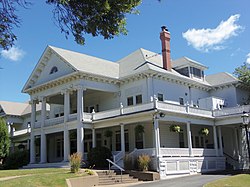Vander Veer Park Historic District
Vander Veer Park Historic District | |
| NRHP reference No. | 85000784[1] |
|---|---|
| Added to NRHP | April 9, 1985 |
The Vander Veer Park Historic District is a
Description


The historic district consists of houses surrounding
History
Vander Veer Park
In 1885 the city of Davenport acquired the property that had been the Scott County Fairgrounds. It is a significant example of landscape planning, and of the civic improvements that were being made by the city in the late 19th and early 20th centuries.
Central Park was renamed Vander Veer after an early Davenport park commissioner in 1911. In the 1930s Civil Works Administration crews altered the park's plan by removing the corner entrances at Brady and Lombard Streets and at Harrison and Lombard Streets. The original street lights and the iron fountain were replaced with modern light standards and a stone-and-concrete fountain that was operated electrically.
Neighborhood

The establishment of Central Park increased the desirability and cost of the surrounding land for residential development.[2] On the east side of Brady Street are the Central Park and Central Park Second additions that were platted in 1891 and 1896, respectively. The Outing Club and Temple Lane additions on the south side of the park, and two Norwood Park additions on the west side of Harrison were platted after 1900.
Davenport's streetcar system was electrified and expanded into residential areas beyond the original city core near the river in 1888. The Brady Street line, which traveled from Second Street to Central Park, aided the area's development as well as the neighborhoods further to the east.[2] Established as a horsecar line in 1870, it was one of Davenport's first streetcar routes and connected the central business district with the county fairgrounds. By the end of the 19th-century, it became a commuter route for businessmen and middle-class office workers.

Because the neighborhood was relatively affluent several of the houses were designed by prominent local architects, and three of them lived near the park.
References
- ^ "National Register Information System". National Register of Historic Places. National Park Service. March 13, 2009.
- ^ a b c d e f Martha Bowers; Marlys Svendsen. "National Register of Historic Places Nomination Form: Vander Veer Park Historic District". National Park Service. Retrieved April 21, 2015. with photos
- OCLC 20501198
External links
![]() Media related to Vander Veer Historic District at Wikimedia Commons
Media related to Vander Veer Historic District at Wikimedia Commons

